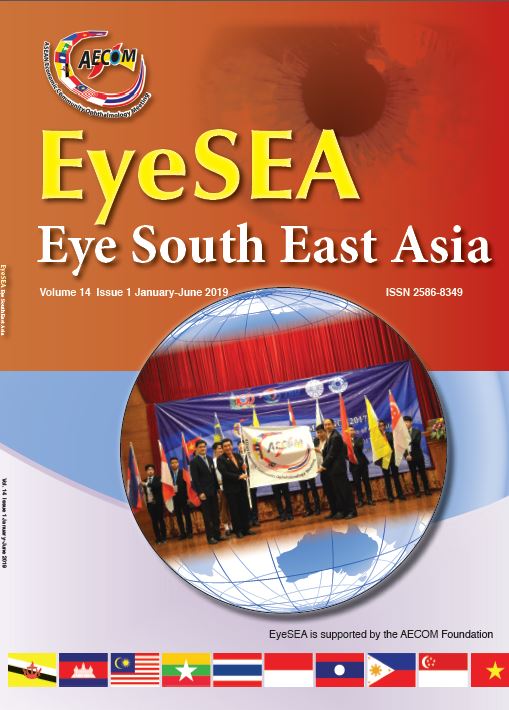A rare case of complex orbital lymphangiohemangioma
Main Article Content
Abstract
Background: Complex orbital lymphangiohemangioma is a rare benign vascular lesions. It usually appears as an enlarging mass without specific clinical features and frequently misdiagnosed. This case report highlighted a case of orbital vascular anomalies which presented as intramuscular hemangioma with lymphangioma.
Results: A 12 years old boy with underlying bronchial asthma, presented with painless progressive enlarging swelling over right medial canthal area and right upper lid since age of 6 years old. His best corrected vision was OD 20/50 , OS 20/20. Right eye showed non tender mass at medial canthal area with no skin changes. Anterior chamber and posterior chamber bilateral eye was unremarkable. CT scan showed soft tissue swelling at the medial part of the right orbit involving the medial part of upper and lower eyelid and medial canthal region, measures approximately 2.1cm x 2.4cm x 3.9cm with blocked nasolacrimal duct suggestive of mucocele. Excision biopsy was performed, the intraoperative findings revealed a mass mixed with fibrosis tissue and microcyst with no definite plane with underlying skin and orbicularis oculi muscle. Histopathology examination showed benign vascular lesion likely intramuscular angioma. 3 weeks post operatively, he developed wound breakdown and exploration under GA was done, which intraoperatively showed multiple small slow oozing from remnant of the lesion with multiple cyst surrounding wall of cavity , bluish lesion and small telangiectatic vessels were seen at the upper lid.
Conclusion: Complex orbital lymphangiohemangioma is a rare benign vascular lesion. The recurrence rate is high even after wide surgical excision due to its microscopically infiltrative pattern of diffusion into the surrounding muscular tissue. Long term clinical and radiological follow up are strongly recommended in order to precisely diagnose and treat further recurrences.
Conflicts of interest: The authors report no conflicts of interest.
Article Details
References
Acta Ophthalmologica Scandinavica 2002;80:336-9.
2.Wolf GT, Daniel F, Krause KJ, Arbor A, Kaufman RS. Intramuscular hemangioma of the head and neck. Laryngoscope 1985;95:210-3.
3.Giudice M, Piazza C , Bolzoni A, Peretti G. Head and neck intramuscular hemagioma: Report of two cases with unusual localization. Eur Arch Otorhinolaryngol 2003;260:498-501.
4.Beham A, Fletcher CD. Intramuscular angioma:a clinicopathological analysis of 74 cases. Histopathology 1991;18:53.
5.Lopez CJL, Fernandez JU ,Baltanas JM, Garcia JAL. Hemangioma of the temporalis muscle: a case report and review of the literature. J Oral MaxillofacSurg 1996;54: 1130-2.
6.Cohen EK, Kressel HY, Perosio T, Burk DL, Dalinka MK, Kanal E, et al. MR imaging of soft-tissue hemangiomas: correlation with pathological findings. AJR Am J Roentgenol 1988;150:1079-81.
7.Buetow PC, Kransdorf MJ, Moser RP, Jelinek JS, Berrey BH. Radiologic appearance of intramuscular hemangioma
with emphasis of MR imaging. AJR Am J Roentgenol 1990;154:563-7.
8.Diego S, Manuela N, Carmela R, Arianna D, Nadia S, Gianfranco P, et al. Coexistence of cavernous hemangioma and other vascular malformations of the orbit. A report of three cases. The neuroradiology J 2014;27:223-31.
9.Müller FW, Pitz S. Orbital pathology. Eur J Radiol. 2004;49(2):105-42.
10.Smoker WR, Gentry LR, Yee NK, Reede DL, Nerad JA. Vascular lesions of the orbit: more than meets the eye.
RadioGraphics 2008;28(1),185-204
11.Schwarcz RM, Simon GJB, Cook T, Golderg RA. Sclerosing therapy as first line treatment for low flow vascular lesions of the orbit. American Journal of Ophthalmology. 2006;141:2.
12.Okada A, Kubota A, Fukuzawa M, Imura K, Kamata S. Injection of bleomycin as a primary therapy of cystic lymphangioma. J Pediatr Surg. 1992;27(4):440–3.
13.Tunç M, Sadri E, Char DH. Orbital lymphangioma: an analysis of 26 patients. Br J Ophthalmol 1999;83:76-80
14.Gündüz K, Demirel S, Yagmurlu B, Erden E. Correlation of surgical outcome with neuroimaging findings in periocular lymphangiomas. Ophthalmology 2006;113:1231-7
15.Suzuki Y, Obana A, Gohto Y, Miki T, Otuka H, Inoue Y. Management of orbital lymphangioma using intralesional
injection of OK-432. Br J Ophthalmol, 2000;84:614-7
16.Yoon JS, Choi JB, Kim SJ, Lee SY. Intralesional injection of OK-432 for vision-threatening orbital lymphangioma.
Graefes Arch Clin Exp Ophthalmol 2007;245:1031-5


